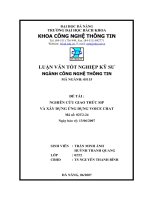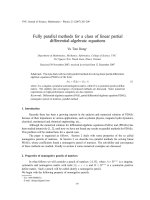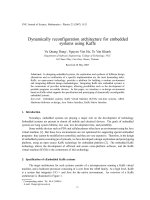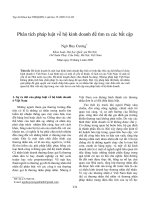Tài liệu Báo cáo : Integrated Cultivation Technique for Microbial Lipid Production by Photosynthetic Microalgae and Locally Oleaginous Yeast pptx
Bạn đang xem bản rút gọn của tài liệu. Xem và tải ngay bản đầy đủ của tài liệu tại đây (512.11 KB, 5 trang )
Abstract—The objective of this research is to study of microbial
lipid production by locally photosynthetic microalgae and oleaginous
yeast via integrated cultivation technique using CO
2
emissions from
yeast fermentation. A maximum specific growth rate of Chlorella sp.
KKU-S2 of 0.284 (1/d) was obtained under an integrated cultivation
and a maximum lipid yield of 1.339g/L was found after cultivation
for 5 days, while 0.969g/L of lipid yield was obtained after day 6 of
cultivation time by using CO
2
from air. A high value of volumetric
lipid production rate (Q
P
, 0.223 g/L/d), specific product yield (Y
P/X
,
0.194), volumetric cell mass production rate (Q
X
, 1.153 g/L/d) were
found by using ambient air CO
2
coupled with CO
2
emissions from
yeast fermentation. Overall lipid yield of 8.33 g/L was obtained
(1.339 g/L of Chlorella sp. KKU-S2 and 7.06g/L of T. maleeae Y30)
while low lipid yield of 0.969g/L was found using non-integrated
cultivation technique. To our knowledge this is the unique report
about the lipid production from locally microalgae Chlorella sp.
KKU-S2 and yeast T. maleeae Y30 in an integrated technique to
improve the biomass and lipid yield by using CO
2
emissions from
yeast fermentation.
Keywords—Microbial lipid, Chlorella sp. KKU-S2, Torulaspora
maleeae Y30, oleaginous yeast, biodiesel, CO
2
emissions
I. INTRODUCTION
HE increasing demand for biofuels will create new
opportunities for microorganisms and other non-food
feedstocks to meet ambitious targets for renewable energy
replacing fossil fuels. Microbial oils, namely single cell oil
(SCO), lipid produced from oleaginous microorganisms
involving yeasts, moulds, and microalgae, which have ability
to accumulate lipids over 20 % of their biomass, are
considered as non-food feedstock promising candidates for
biodiesel production due to some advantages such as short
production period, higher biomass production and faster
growth compared to other energy crops, easiness to scale up
[1, 2]. Microalgae have the highest oil or lipid yield among
various plant oils, and the lipid content of some microalgae
has up to 80% and the compositions of microalgal oils are
mainly triglyceride which is the right kind of oil for producing
biodiesel [3]. Microalgae may assume many types of
metabolisms, such as photoautotrophic, heterotrophic,
mixotrophic and photoheterotrophic growths [4]. In
photoautotrophic growth, the sole energy source for biomass
production is light energy and the sole carbon source is
inorganic compounds especially carbon dioxide (CO
2
).
M. Puangbut is with the Graduate School of Khon Kaen University, Khon
Kaen 40002, Thailand (e-mail: ).
R. Leesing is with the Department of Microbiology, Faculty of Science,
Khon Kaen University, Khon Kaen 40002, Thailand (Corresponding author,
Tel. & fax: 0066-43-202-377; e-mail: ).
CO
2
as a nutrient represents one of the most costly
components in the cultivation of microalgae. Therefore a
system that couples a waste CO
2
source with the cultivation of
CO
2
fixing microalgae can not only reduce cultivation costs
but also mitigate or remove CO
2
, greenhouse gas (GHG) as an
environmental pollution. Waste CO
2
can be provided by the
flue gases from power plants or from agro-industrial plants [4,
5]. In the case of agro-industrial sector, CO
2
can be provided
by using CO
2
emissions from the ethanol fermentation by
yeast. The carbon credits obtained for removal of CO
2
from
the ethanol plant emissions are non-taxable benefits [5]. The
biofixation of CO
2
by microalgae has been proven to be an
efficient and economical method, mainly due to the
photosynthetic ability of these microorganisms to use this gas
as a source of nutrients for their development.
The microalgae Chlorella sp., especially C. protothecoides
and C. vulgaris are two widely available microalgae strains in
the commercial applications for food and nutritional purposes.
They showed great potentials as future industrial biofuel
producers due to their high growth rate, and their high oil
contents and they can be cultured both under photoautotrophic
and heterotrophic conditions. However, the locally microalgae
Chlorella sp. KKU-S2 isolated from freshwater taken from
pond in the area of Khon Kaen province, northeastern region
of Thailand, can accumulates much higher production of
lipids, and the components of fatty acid from extracted lipid
were palmitic acid, stearic acid, oleic acid and linoleic acid
which similar to vegetable oils and suitable for biodiesel
production [6].
In the last decade there is a great attention on oleaginous
yeasts because some of them are capable of accumulating
large amounts of lipids in their cells. Oleaginous yeast can
produce high amount of lipid contents with characteristics
similar to vegetable oil. It also has a high growth rate and can
be cultured in a single medium with low cost substrate [7, 8].
The locally oleaginous yeast Torulaspora maleeae Y30 has
proved to accumulate lipid efficiently not only on glucose but
also on sugarcane molasses and three major constituent fatty
acids were palmitic acid, stearic acid, and oleic acid that are
comparable to vegetable oils which can be used as biodiesel
feedstock [9].
Lipid production from yeast fermentation produces CO
2
which can be provided for photosynthetic microalgae by using
an integrated culture design that incorporates both CO
2
consumption and microbial oil production appear to be the
best approach to enable industrial application of these new
technologies for environmental benefit. Therefore, the
objective of this work is to investigate the production of
microbial lipid by photosynthetic microalgae Chlorella sp.
KKU-S2 and oleaginous yeast T. maleeae Y30 via integrated
technique of photosynthesis and fermentation.
Integrated Cultivation Technique for Microbial
Lipid Production by Photosynthetic Microalgae
and Locally Oleaginous Yeast
T
Mutiyaporn Puangbut, Ratanaporn Leesing
975
World Academy of Science, Engineering and Technology 64 2012
II. MATERIALS
AND
METHODS
A. Microalgae and Culture conditions
Chlorella sp. KKU-S2 was
isolated from freshwater taken
from pond in
the area of Khon Kaen province, Northeastern
Thailand [6]. The seed culture
was pre
basal Bristol medium
at room temperature
continuous illuminated from overhead by
white fluorescent lamps. The basal
Bristol medium was
consisted of (mg/L): NaNO
3
250, K
2
HPO
CaCl
2
25, NaCl 25, MgSO
4
.7H
2
O 75,
MnSO
4
.2H
2
O 0.3, ZnSO
4
7H
2
O 0.2, H
3
BO
0.06, and pH was adjusted to 7
.0 before sterilization.
B. Yeast Strain and Culture Conditions
Torulaspora maleeae Y30
used in this study was isolated
from soil samples taken from forest in the area of Chulabhorn
Dam, Chaiyapoom Prov
ince Northeastern of Thailand [
maleeae Y30
was maintained on YM agar slant. The seed
cultures were cultivated onto Lipid accumulation (LA)
medium supplemented with 20g/L glucose at 30
incubator shaker at a shaking speed of
150 rpm for 1 day.
LA medium was consisted of (g/L):
(NH
0.4, MgSO
4
.7H
2
O 1.5, ZnSO
4
0.0044, CaCl
0.0005, CuSO
4
0.0003 and yeast extract 0.75 and pH was
adjusted to 5.5 before sterilization.
C.
Effect of Nitrogen Concentration on Growth and
Production
Batch cultivations were performed in
40
flasks with a working volume of 2
0
supplemented with
different concentration of urea
inoculated with 10% (v/v) seed culture of microalgae and
cultivated at ambient temperature (30°
C)
illumination by using 80W cool-white
fluorescent lamps.
D.
Integrated Cultivation Technique for Lipid Production
Microbial lipids production via integrated technique was
performed by oleaginous yeast and microalgae.
each strain
was performed in 4000mL Erlenmeyer flask with a
working volume of 2000mL. Yeast T
.
cultivated onto LA medium
(20g/L glucose)
Chlorella sp. KKU-S2
were cultivated onto Bristol medium
with 10% (v/v) seed culture of each strain
room temperature
under continuous illumination by using
80W cool-white fluorescent lamps.
The mixing of air and CO
from yeast fermentation was aerated
during
schematic of a yeast fermentation
flask
microalgae flask is shown in Fig. 1. The
CO
yeast fermentation is split and
connected
surrounding microalgae flask
and combined with
for photosynthetic microalgae growth.
growth and lipid production, cultivation of microalgae
carried out with ambient air aerated but
without the addition of
CO
2
emissions from yeast fermentation.
E. Analytical Methods
The biomass concentra
tion was determined by measuring
the optical density of samples at 680 nm wavelength (OD
METHODS
isolated from freshwater taken
the area of Khon Kaen province, Northeastern
of
was pre
-cultivated onto the
at room temperature
for 3 days and
continuous illuminated from overhead by
using 80W cool-
Bristol medium was
HPO
4
75, KH
2
PO
4
175,
O 75,
and FeCl2 0.3,
BO
3
0.2, CuSO
4
.5H
2
O
.0 before sterilization.
used in this study was isolated
from soil samples taken from forest in the area of Chulabhorn
ince Northeastern of Thailand [
9]. T.
was maintained on YM agar slant. The seed
cultures were cultivated onto Lipid accumulation (LA)
medium supplemented with 20g/L glucose at 30
°
C in an
150 rpm for 1 day.
The
(NH
4
)
2
SO
4
0.1, KH
2
PO
4
0.0044, CaCl
2
0.0025, MnCl
2
0.0003 and yeast extract 0.75 and pH was
Effect of Nitrogen Concentration on Growth and
Lipid
40
00mL Erlenmeyer
0
00mL of medium
different concentration of urea
, flasks were
inoculated with 10% (v/v) seed culture of microalgae and
C)
under continuous
fluorescent lamps.
Integrated Cultivation Technique for Lipid Production
Microbial lipids production via integrated technique was
performed by oleaginous yeast and microalgae.
Cultivation of
was performed in 4000mL Erlenmeyer flask with a
.
maleeae Y30 was
(20g/L glucose)
and microalgae
were cultivated onto Bristol medium
with 10% (v/v) seed culture of each strain
and cultivated at
under continuous illumination by using
The mixing of air and CO
2
during
the cultivation. A
flask
connected to
CO
2
produced by the
connected
directly into the
and combined with
ambient air
To comparison of
growth and lipid production, cultivation of microalgae
was
without the addition of
tion was determined by measuring
the optical density of samples at 680 nm wavelength (OD
680
)
in a Spectrophotometer and comparing these values with
prepared standard calibration curves of optical density versus
dry biomass weight
of microalgae strain.
The
culture broth (5 mL) was centrifuged at 5,000 rpm for 5
min. Harvested
biomass was washed twice with 5
distilled water.
Duplicate samples
analyzed for lipid yield.
The total lipids were determined by
the modified method of
modifications [10]. L
ipid content was
per gram dry biomass.
Fig. 1 Simplified schematic of
yeast
microalgae
cultivation for microbial lipid production
ambient temperature under continuous illuminat
white fluorescent lamps
F.
Determination of Growth Kinetic
Volumetric lipid
product
determined from a plot between lipids (g/L) and fermentation
time, specific product
yield (
determined using relationship d
production rate (Q
X
, g/L/d
) was determined from a plot of dry
cells (g/L) versus time of fermentation (d).
growth rate (µ)
of each strain
the linear regression of time (days)
to the equation: µ = (lnX
2
–
are the biomass
dry cell weight concentration (g/L) at time t
and t
1
, respectively,
while specific rate of li
g lipid /g cells/d
) was a multiple of
in a Spectrophotometer and comparing these values with
prepared standard calibration curves of optical density versus
of microalgae strain.
culture broth (5 mL) was centrifuged at 5,000 rpm for 5
biomass was washed twice with 5
mL of
Duplicate samples
of harvested biomass were
The total lipids were determined by
the modified method of
Know and Rhee (1986) with
ipid content was
expressed as gram lipid
yeast
fermentation and photosynthetic
cultivation for microbial lipid production
, cultivated at
ambient temperature under continuous illuminat
ed with 80W cool-
white fluorescent lamps
Determination of Growth Kinetic
product
ion rate (Q
P
, g/L/d) was
determined from a plot between lipids (g/L) and fermentation
yield (
Y
P/X
, g lipid/g cell) was
determined using relationship d
P/dX, Volumetric cell mass
) was determined from a plot of dry
cells (g/L) versus time of fermentation (d).
The specific
of each strain
was calculated from the slope of
the linear regression of time (days)
and dry biomass according
lnX
1
) / (t
2
– t
1
), where X
2
and X
1
dry cell weight concentration (g/L) at time t
2
while specific rate of li
pid production (q
P
,
) was a multiple of
µ and Y
P/X
[11, 12].
World Academy of Science, Engineering and Technology 64 2012
976
III. RESULTS AND DISCUSSION
A. Effect of Nitrogen Concentration on Growth and Lipid
Production
There was a correlation between the concentration of cell
dry weight (g/L) and the optical density at 680nm (OD
680
) for
photoautotrophic cultured of Chlorella sp. KKU-S2. The
following regression equation, y = 1.5343x, (R
2
= 0.977) was
obtained from the measurements, where y is the cell dry
weight and x is OD
680
.
As a preliminary step, photoautotrophic growth of
microalgae was investigated for studying the effect of organic
nitrogen concentration on growth and lipid production. When
using different nitrogen concentrations, NaNO
3
was removed
from the basal Bristol medium and replaced by organic
nitrogen source urea. The urea concentrations of 5, 10 and 15
g/L were used as the initial nitrogen source to investigate the
effects on cell growth and lipid yield.
Fig. 2 Biomass concentration (a), lipid yield (b) of Chlorella sp.
KKU-S2 on Bristol medium supplemented with different nitrogen
concentration under photoautotrophic cultivation
Biomass and lipid yield of Chlorella sp. KKU-S2 with time
in batch cultivation are presented in Fig. 2 and Table 1.
Growth on different concentration of urea resulted in a
significant effect on cell biomass and lipid yield. A maximum
specific growth rate obtained was 0.109 (1/d) when initial urea
concentration was 5g/L. A maximum biomass of 2.36g/L with
lipid yield of 0.184g/L was obtained by cultivation with an
initial urea concentration of 5g/L. Chlorella sp. KKU-S2
showed low growth when cultured with an initial urea
concentration of 15g/L with a biomass of 1.489g/L with
specific growth rate (
µ
) of 0.091 (1/d). There are no
significant different of volumetric lipid production rate (Q
P
)
and specific rate of lipid production (q
P
) by cultivation with an
initial urea concentration of 5g/L and 10 g/L.
B. Microbial Lipid Production by an Integrated
Cultivation of yeast and microalgae
Batch cultures were investigated to improve the suitable
cultivation technique for growth and lipid production from
yeast T. maleeae Y30 and photoautotrophic microalgae
Chlorella sp. KKU-S2 (Fig. 1). Time course of cell growth of
yeast T. maleeae Y30 was presented in Fig. 3.
Fig. 3 Time course of cell growth of T. maleeae Y30 on LA medium
using glucose as carbon source, cultivated at ambient temperature for
7 days
After cultivation for 7 days, a biomass of yeast T. maleeae
Y30 and lipid yield reached the maximum of 23.63 g/L and
7.06 g/L were obtained, respectively. Cellular lipid content of
26.8% was obtained. Waste CO
2
produced by the fermentation
of yeast T. maleeae Y30 during lipid production, is connected
directly into the surrounding microalgae flask and combined
with ambient air for photosynthetic microalgae Chlorella sp.
KKU-S2 growth. As shown in Fig. 4, there are significant
TABLE I
EFFECT OF UREA CONCENTRATION ON GROWTH KINETIC
PARAMETERS OF CHLORELLA SP. KKU-S2 UNDER
PHOTOAUTOTROPHIC CULTIVATION AT AMBIENT TEMPERATURE
Kinetic parameters Urea concentration (g/L)
5 10 15
Biomass (X, g/L) 2.361
2.023
1.489
Lipid yield (P, g/L)
0.184 0.171 0.091
µ (1/d)
0.109 0.104 0.073
Q
P
0.013
0.012
0.007
Q
X
0.169 0.144 0.106
Y
P/X
0.078
0.084
0.061
q
P
0.009
0.009
0.004
World Academy of Science, Engineering and Technology 64 2012
977
different of optical density (OD
680
)
changes
growth of microalgae during
cell growth using different
sources of CO
2
, higher value of OD
680
of 1.27
cultivation of microalgae by using CO
2
from air
CO
2
emissions from yeast fermentation
for 7 days
the cultivation by using CO
2
from air.
The OD
obtained by using CO
2
from air.
Fig. 4 Optical density (OD
680
) of
Chlorella
photoautotrophic cultivation by using CO
2
emissions
from yeast fermentation (Air +CO
(Air)
A
maximum biomass of 8.44g/L was obtained by
cultivation using CO
2
from ambient air and CO
from yeast fermentation (Air+CO
2
) after 7 days of cultivation,
while a biomass of 6.34g/L was found when
KKU-S2 was cultivated using CO
2
from air
2). A maximum lipid yield of 1.339
g/L was found after
cultivation for 5 days by using
mixing of
emissions
from yeast fermentation, while 0.9
yield was obtained after day
6 of cultivation
from air.
There are significant different of volumetric lipid
production rate (Q
P
),
specific product yield
cell mass production rate (Q
X
) and
specific rate of lipid
production (q
P
) by
using different source of CO
of all parameters was found when using CO
coupled with CO
2
emissions
from yeast fermentation for
supported the growth and lipid production of microalgae
Chlorella sp. KKU-S2.
Nannochloropsis oculata
increases in biomass and lipid content when the CO
concentration supplied was increased
Scenedesmus obliquus and
Chlorella kessleri
particularly high potential for bio-
fixation of CO
oleaginous
organisms are grown with an excess
limited quantity of nitrogen, they may
concentration of cellular lipid.
Cultivation
microorganisms
with low nitrogen in the medium,
the decrease of the activity of nicotinamide
dinucleotide isocitrate dehydrogenase (NADIDH)
tricarboxylic acid cycle is
repressed, metabolism pathway
altered and protein
synthesis stopped and lipid accumulation is
activated [15, 16].
changes
observed in the
cell growth using different
of 1.27
was obtained by
from air
mixing with
for 7 days
than that of
The OD
680
of 0.913 was
Chlorella
sp. KKU-S2 under
2
coupled with CO
2
from yeast fermentation (Air +CO
2
) and CO
2
from air
maximum biomass of 8.44g/L was obtained by
from ambient air and CO
2
emissions
) after 7 days of cultivation,
while a biomass of 6.34g/L was found when
Chlorella sp.
from air
(Fig. 5 and Table
g/L was found after
mixing of
air and CO
2
from yeast fermentation, while 0.9
69g/L of lipid
6 of cultivation
by using CO
2
There are significant different of volumetric lipid
specific product yield
(Y
P/X
), volumetric
specific rate of lipid
using different source of CO
2
. A high value
of all parameters was found when using CO
2
from mixing air
from yeast fermentation for
supported the growth and lipid production of microalgae
Nannochloropsis oculata
exhibited
increases in biomass and lipid content when the CO
2
concentration supplied was increased
[13]. Similarly,
Chlorella kessleri
showed a
fixation of CO
2
[14]. When
organisms are grown with an excess
of carbon and
limited quantity of nitrogen, they may
accumulate high
Cultivation
of oleaginous
with low nitrogen in the medium,
results to
the decrease of the activity of nicotinamide
adenine
dinucleotide isocitrate dehydrogenase (NADIDH)
then the
repressed, metabolism pathway
synthesis stopped and lipid accumulation is
Fig. 5 Biomass (a)
and lipid yield
photoautotrophic cultivation
emissions
from yeast fermentation (Air +CO
(Air)
In case of integrated cultivation process, overall lipid yield
of 8.33 g/L was obtained (1.339 g/L of
and 7.06g/L of T. maleeae
Y30
yield was found from
Chlorella
integrated cultivation technique
photoautotrophic
microalgae
existing
yeast fermentation
feasible by the generation of two new revenue
TABLE
E
FFECT
O
F
C
O
2
O
N
G
ROWTH
K
INETIC
S2
U
NDER
P
HOTOAUTOTROPHIC
C
ULTIVATION
Kinetic parameters
Culture condition
Air + CO
Biomass (X, g/L)
6.920
Lipid yield (P, g/L)
1.339
µ (1/d)
0.284
Q
P
0.223
Q
X
1.153
Y
P/X
0.194
q
P
0.055
1
Cultivation time for 5 days,
2
C
ultivation time for 6 days
and lipid yield
(b) of Chlorella sp. KKU-S2 under
photoautotrophic cultivation
by using CO
2
coupled with CO
2
from yeast fermentation (Air +CO
2
) and CO
2
from air
(Air)
In case of integrated cultivation process, overall lipid yield
of 8.33 g/L was obtained (1.339 g/L of
Chlorella sp. KKU-S2
Y30
) while only 0.969g/L of lipid
Chlorella
sp. KKU-S2 using non-
integrated cultivation technique
. The integration of the
microalgae
cultivation systems into an
yeast fermentation
system is made economically
feasible by the generation of two new revenue
streams:
TABLE
II
INETIC
PARAMETERS OF CHLORELLA SP. KKU-
ULTIVATION
AT AMBIENT TEMPERATURE
Culture condition
s
Air + CO
2
emissions
1
Air
2
6.920
5.447
1.339
0.969
0.284
0.239
0.223
0.194
1.153
1.089
0.194
0.178
0.055
0.042
ultivation time for 6 days
World Academy of Science, Engineering and Technology 64 2012
978
microbial lipid from microalgae and oleaginous yeast for used
as potential feedstock for biodiesel production and the capture
of CO
2
emissions from the yeast fermentation stage [4, 5].
In conclusion, we present a cultivation technique for the
integrated growth and lipid production of yeast and
microalgae. To our knowledge this is the unique report about
the microbial lipid production from locally photoautotrophic
microalgae Chlorella sp. KKU-S2 and oleaginous yeast T.
maleeae Y30 in an integrated technique to improve the
biomass and lipid yield using CO
2
emissions from yeast
fermentation resulted to reduce cultivation costs and also
remove and value-added of CO
2
, greenhouse gas, this process
could be so called that environmental friendly process. This
cultivation method will open new perspectives in the
production of microbial lipid which could be used as potential
feedstock for biodiesel production. In further works,
increasing of microalgal biomass and lipid yield will be
investigated in a 20L photobioreactor via integrated
cultivation technique of photoautotrophic microalgae by using
CO
2
emissions from yeast fermentation and photoautotrophic
cultivation by using pure CO
2
or CO
2
from flue gases and then
completed with the biodiesel production from microbial lipid
via direct and indirect transesterification methods.
A
CKNOWLEDGMENT
This work was supported by the Higher Education Research
Promotion and National Research University Project of
Thailand, Office of the Higher Education Commission,
through the Biofuel Cluster of Khon Kaen University under
the research project entitled “Development of biodiesel
productions from locally potential freshwater microalgae
under photoautotrophic cultivation”. Grant for traveling
support from Graduate School of Khon Kaen University is
gratefully acknowledged.
R
EFERENCES
[1] Chisti, Y. (2007) Biodiesel from microalgae. Biotechnol Adv 25: 294-
306.
[2] Amin, S. (2009) Review on biofuel oil and gas production processes
from microalgae. Energy Conversion and Management 50:1834-1840.
[3] Mata, T.M., Martins, A.A., Caetano, N.S., (2010) Microalgae for
biodiesel production and other applications: a review. Renew Sust Energ
Rev 14: 217–232.
[4] Huang, G.H., Chen, F., Wei, D., Zhang, X.W., and Chen, G. (2010)
Biodiesel production by microalgal biotechnology. Appl Energy 87:38–
46.
[5] Powell, E.E., Hill, G.A. (2009) Economic assessment of an integrated
bioethanol–biodiesel–microbial fuel cell facility utilizing yeast and
photosynthetic algae. Chem Eng Res Design 87: 1340-1348.
[6] Leesing, R., Nontaso, N. (2010) Microalgal oil production by green
microalgae under heterotrophic cultivation. KKU Res J 15 (9): 787-793.
[7] Yong-Hong, L., Bo, L., Zong-Bao, Z., Feng-Wu, B., (2006)
Optimization of culture conditions for lipid production by
Rhodosporidium toruloides. Chinese J Biotechnol 22: 650–656.
[8] Zhu, L.Y., Zong, M.H. and Wu, H. (2008) Efficient lipid production
with Trichosporon fermentans and its use for biodiesel preparation.
Biores Technol 99:7881-7885.
[9] Leesing, R., Karraphan, P. (2011) Kinetic growth of the isolated
oleaginous yeast for lipid production. African J Biotechnol 10 (63):
13867-13877.
[10] Kwon, D.Y. and Rhee, J.S. (1986) A Simple and rapid colorimetric
method for determination of free fatty acids for lipase assay. J Am Oil
Chem Soc 63:89-92.
[11] Lee, J.M. (1992) Biochemical Engineering. Prentice Hall international,
New Jersey, pp.138-148.
[12] Wood A.M., Everroad R.C., Wingard L.M. (2005) Measuring growth
rates in microalgal cultures. In: Andersen RA, editor. Algal culturing
techniques. Elsevier Academic Press. p. 269-285.
[13] Richmond, A. (2004) Handbook of microalgal culture: biotechnology
and applied phycology. Blackwell Science.
[14] Chiu, S.Y., Kao, C.Y., Chen, C.H., Kuan, T.C., Ong, S.C., Lin, C.S.
(2008) Reduction of CO
2
by a highdensity culture of Chlorella sp. in a
semicontinuous photobioreactor. Bioresour Technol 99:3389–3396.
[15] Ratledge C., Wynn, J.P. (2002) The biochemistry and molecular biology
of lipid accumulation in oleaginous microorganisms. Adv. Appl.
Microbiol. 51: 1-51.
[16] Tehlivets, O., Scheuringer, K., Kohlwein, S.D. (2007) Fatty acid
synthesis and elongation in yeast. Biochimica et Biophysica Acta, 1771:
255-270.
World Academy of Science, Engineering and Technology 64 2012
979









